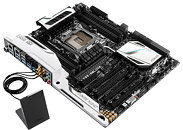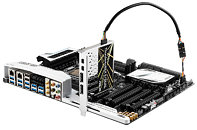Friday, August 29th 2014

ASUS Announces X99 Series Motherboards
ASUS today announced X99-Deluxe, X99-Pro and X99-A, three new ATX motherboards based on the Intel X99 chipset and packed with exclusive technologies, including OC Socket and 5-Way Optimization, to ensure ultimate performance from the latest LGA 2011-v3 Intel Core i7 processors.
X99-Deluxe is the flagship model, with a bundled ASUS Hyper M.2 x4 expansion card for ultra-fast 32 Gbit/s transfer speeds; onboard 3x3 (3T3R) 802.11ac for ultra-fast Wi-Fi speeds of up to 1,300 Mbit/s; and an ASUS Fan Extension Card for flexible additional cooling. With a cool, streamlined outlook that includes a broad, striking-white shield, X99-Deluxe and X99-Pro also deliver the futuristic style and strong performance demanded by PC enthusiasts.All new X99 Series motherboards also feature Crystal Sound 2 for flawless audio; Turbo LAN technology for lag-free online gaming and productivity; and our renowned UEFI BIOS for intuitive setup and control.
OC Socket and 5-Way Optimization for pumped overclocking performance
X99 Series motherboards are equipped with a brand-new ASUS invention - our patent-pending OC Socket. This unique socket includes extra pins that connect proprietary circuitry to extra contacts found on Haswell-E's land grid array (LGA), and is 100% compatible with Intel's new LGA 2011-v3 ('Haswell-E') processors. In combination with the ASUS UEFI BIOS, OC Socket enables higher DDR4 memory frequencies, lower latencies and enhanced stability while overclocking, extending all the way to extreme overclocking conditions, such as Liquid Nitrogen (LN2).Users are also able to increase DDR4 memory frequencies to 3200 MHz and beyond, even with all eight DIMM slots populated.
PC enthusiasts also benefit from exclusive 5-Way Optimization technology to dynamically optimize an X99-Deluxe-based PC with one click. First up is Turbo Processor Unit (TPU), which offers precise voltage control and advanced monitoring for both the CPU and the graphics card. Then there's Energy Processing Unit (EPU) to deliver system-wide real-time power savings, controlled via a simple onboard switch or the easy-to-use AI Suite 3 utility.
5-Way Optimization technology also includes the Digi+ voltage-regulator module (VRM) to enhance performance, increase efficiency and ensure reliability, and Fan Xpert 3 for peerless customized fan control. Completing the 5-Way Optimization technology line-up is Turbo App, an intuitive tuning panel to tailor and boost all parts of the system for specific games or programs.
Loaded with extreme hardware for extreme builds
X99-Deluxe is a high-end motherboard loaded with extras for truly awesome builds. The bundled Hyper M.2 x4 expansion card gives users flexibility to equip their systems with up to two M.2 devices to enjoy transfer speeds of up to 32 Gbit/s. Hyper M.2 x4 supports M.2 devices from the smallest 30 mm (2230) to full-length 110 mm (221100) cards.
The supplied ASUS Fan Extension Card provides flexible additional cooling in the shape of three 4-pin/3-pin fan headers. With a hardware-level PWM/DC mode, Fan Extension Card offers exceptional control and is ideal for water-cooled or extreme-airflow high-performance systems.
X99-Deluxe also has super-fast 802.11ac wireless connectivity on board. The three-transmit, three-receive (3x3) antenna configuration enables wireless speeds of up to 1,300 Mbit/s.
In common with the other X99-series motherboards, X99-Deluxe supports the ASUS ThunderboltEX II expansion card. This gives users the freedom to add Thunderbolt 2 connectivity to X99-Deluxe at any time for bi-directional transfer speeds up to 20 Gbit/s - that's four times (4X) faster than USB 3.0.
A complete X99 line-up
X99-Pro and X99-A complete the ASUS X99 motherboard line-up. Both boards will arrive slightly later than X99-Deluxe but share many of the same powerful features.
X99-Deluxe is the flagship model, with a bundled ASUS Hyper M.2 x4 expansion card for ultra-fast 32 Gbit/s transfer speeds; onboard 3x3 (3T3R) 802.11ac for ultra-fast Wi-Fi speeds of up to 1,300 Mbit/s; and an ASUS Fan Extension Card for flexible additional cooling. With a cool, streamlined outlook that includes a broad, striking-white shield, X99-Deluxe and X99-Pro also deliver the futuristic style and strong performance demanded by PC enthusiasts.All new X99 Series motherboards also feature Crystal Sound 2 for flawless audio; Turbo LAN technology for lag-free online gaming and productivity; and our renowned UEFI BIOS for intuitive setup and control.
OC Socket and 5-Way Optimization for pumped overclocking performance
X99 Series motherboards are equipped with a brand-new ASUS invention - our patent-pending OC Socket. This unique socket includes extra pins that connect proprietary circuitry to extra contacts found on Haswell-E's land grid array (LGA), and is 100% compatible with Intel's new LGA 2011-v3 ('Haswell-E') processors. In combination with the ASUS UEFI BIOS, OC Socket enables higher DDR4 memory frequencies, lower latencies and enhanced stability while overclocking, extending all the way to extreme overclocking conditions, such as Liquid Nitrogen (LN2).Users are also able to increase DDR4 memory frequencies to 3200 MHz and beyond, even with all eight DIMM slots populated.
PC enthusiasts also benefit from exclusive 5-Way Optimization technology to dynamically optimize an X99-Deluxe-based PC with one click. First up is Turbo Processor Unit (TPU), which offers precise voltage control and advanced monitoring for both the CPU and the graphics card. Then there's Energy Processing Unit (EPU) to deliver system-wide real-time power savings, controlled via a simple onboard switch or the easy-to-use AI Suite 3 utility.
5-Way Optimization technology also includes the Digi+ voltage-regulator module (VRM) to enhance performance, increase efficiency and ensure reliability, and Fan Xpert 3 for peerless customized fan control. Completing the 5-Way Optimization technology line-up is Turbo App, an intuitive tuning panel to tailor and boost all parts of the system for specific games or programs.
Loaded with extreme hardware for extreme builds
X99-Deluxe is a high-end motherboard loaded with extras for truly awesome builds. The bundled Hyper M.2 x4 expansion card gives users flexibility to equip their systems with up to two M.2 devices to enjoy transfer speeds of up to 32 Gbit/s. Hyper M.2 x4 supports M.2 devices from the smallest 30 mm (2230) to full-length 110 mm (221100) cards.
The supplied ASUS Fan Extension Card provides flexible additional cooling in the shape of three 4-pin/3-pin fan headers. With a hardware-level PWM/DC mode, Fan Extension Card offers exceptional control and is ideal for water-cooled or extreme-airflow high-performance systems.
X99-Deluxe also has super-fast 802.11ac wireless connectivity on board. The three-transmit, three-receive (3x3) antenna configuration enables wireless speeds of up to 1,300 Mbit/s.
In common with the other X99-series motherboards, X99-Deluxe supports the ASUS ThunderboltEX II expansion card. This gives users the freedom to add Thunderbolt 2 connectivity to X99-Deluxe at any time for bi-directional transfer speeds up to 20 Gbit/s - that's four times (4X) faster than USB 3.0.
A complete X99 line-up
X99-Pro and X99-A complete the ASUS X99 motherboard line-up. Both boards will arrive slightly later than X99-Deluxe but share many of the same powerful features.



7 Comments on ASUS Announces X99 Series Motherboards
www.computerbase.de/2014-08/asus-x99-mainboards-mehr-pins-oc-sockel-garantie-intel/
btw since thunderbolt interface not used so widely, you may not need them so its ok to keep them in the box
For those who want to include the ASUS ThunderboltEX II card they will likely have to buy it separately.
Personally I am not concerned with routing such a cable for a number of reasons. First I feel like I can route the cables fairly easily. Second, its a really small and thin cable. Lastly, I'm not going to be staring at the board once I have it all set up. If anything, once it's configured and setup I won't be looking at the board again unless either something is wrong or I am doing an upgrade. Even then it should be a quick endeavor.
Edit:
Also, ASUS might just release another board with Thunderbolt II built in rather then going through the TB_Header. Such a board would probably cost considerably more but its probably perfect for those anal-retentive about such cable clutter.
What I don't quite get is why ASUS changed the header pin out for the TB_Header which requires a transition cable as seen in the photo with ThunderboltEX II card. This doesn't really bother me either way though.